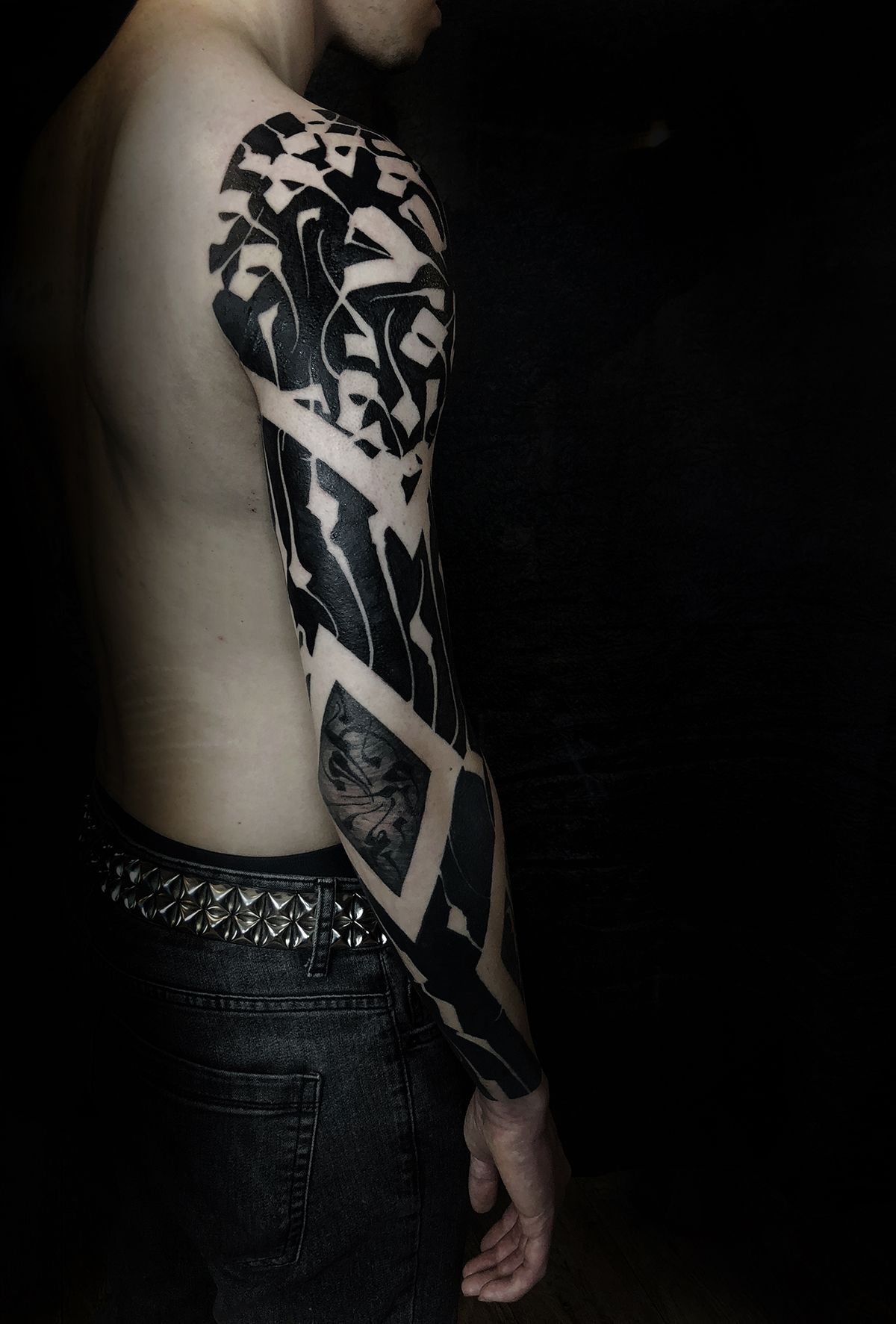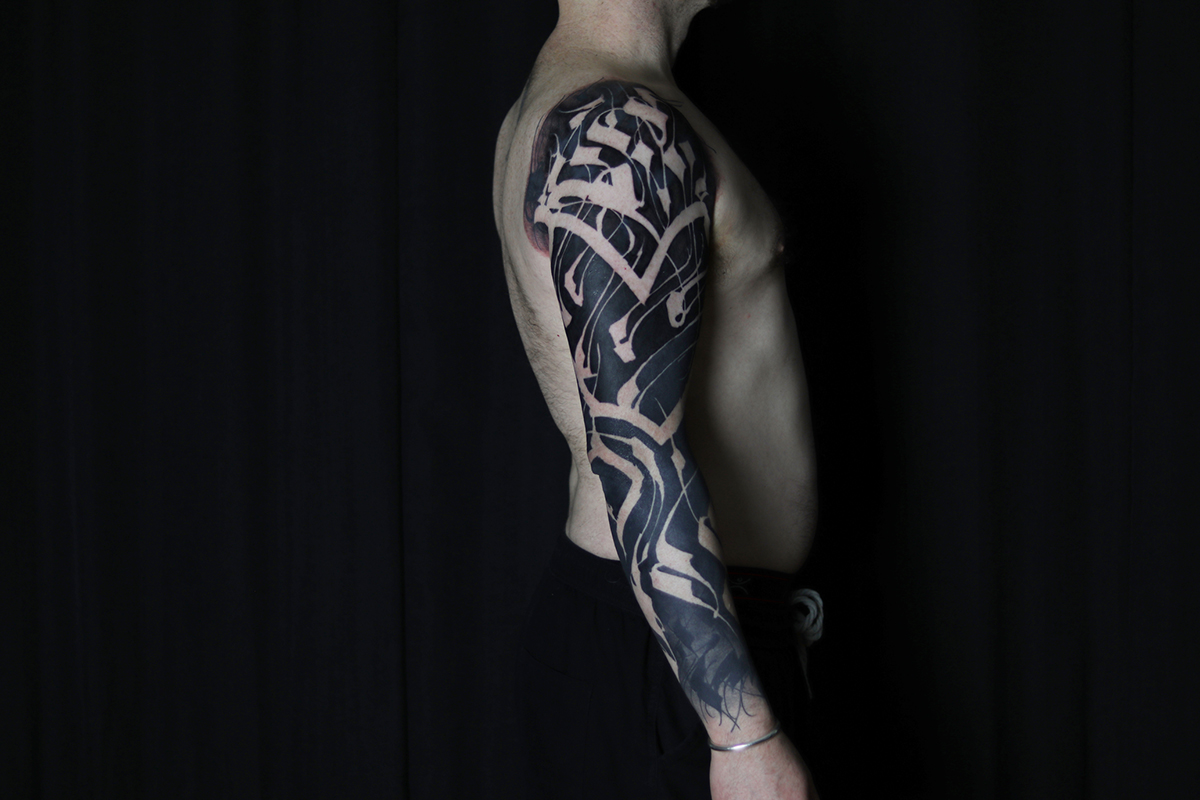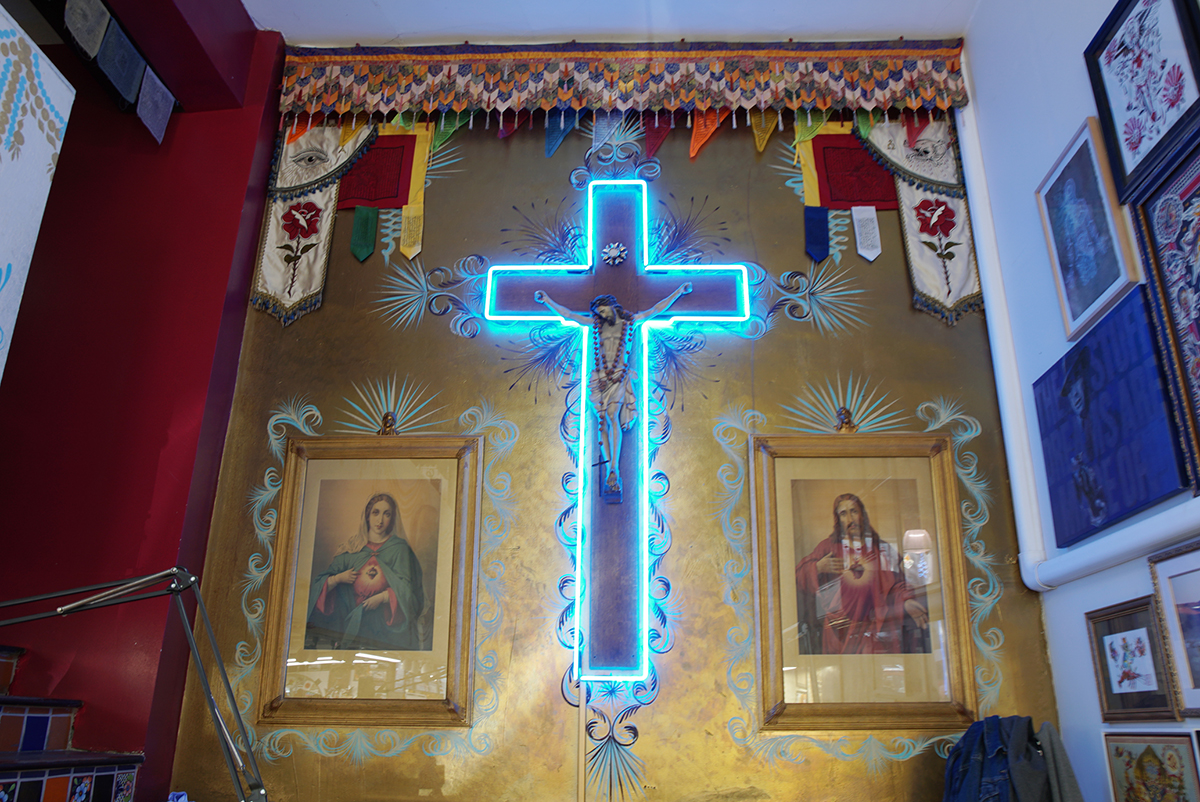Gordoletters, a Portuguese artist with a graffiti background, has been tattooing since 2008. He was inspired by architecture and calligraphy and incorporated elements from several civilizations, including Iran, Egypt, and Japan, to create his free-flowing abstract tattoos. Gordoletters, like the Renaissance man, enjoys building his tools, such as calligraphy nibs and tattoo machines, and is skilled in a variety of disciplines, including painting, drawing, and design. He is always on the lookout for new ways to push his creativity and personal boundaries. To have fun, be kind to others, and leave a lasting impression on the world.

You started traveling again. What were the last two years with the Pandemic like for you? Were you mainly located in Portugal?
We are meeting at Temple Tattoo studio in Oakland, California. Yes, I stayed at home in Portugal. I didn’t work as much as usual, and traveling has been complicated. It’s been a different experience; instead of traveling, I’ve been more concerned with rediscovering myself and developing my work in ways that I don’t normally have the time for. I don’t have time to be bored, but I create when I am, so I do many things. Even though I don’t want to forget about people who have had a difficult time during the pandemic, my personal experience was positive and productive. And I got to spend a lot of time with my girlfriend (who is also a tattoo artist and was traveling separately), which was both welcome and beneficial.


What did you do to keep busy?
I invested time in my workshop, such as finding a new way to paint. I built tools for my calligraphy paintings and built tattoo machines.


Temple Tattoo is owned by the legend Freddy Corbin; what is it like to be a guest artist here?
Today, I’m actually at Freddy’s station. Everyone is amazing here! The whole crew has been nothing but nice. And, of course, being invited by Freddy is the icing on the cake. It’s hard to put into words because sometimes you’d say, “oh, it’s like a dream come true,” but I never really dreamed of this. I would not dare to imagine this. It’s a fantastic achievement!


“It’s one of those moments that is hard to believe, from where I came from, to here, was a long journey,” you’ve said previously. Would you please elaborate on what you mean?
The easiest way to understand is to see where I came from, which I don’t mean any disrespect for the tattoo shop I started at, but it was small in my small hometown outside of Lisbon. The studio had great artists, and I wasn’t even that good, honestly. I thought back then that I would probably need a second job at a restaurant to make some extra bucks while tattooing. When I began traveling, it helped me evolve and understand tattooing because it is not just drawing; it is about meeting people [interacting and communicating] is a big part of this.


You ventured out into the world. Was it because Portugal was not enough or the market was too small?
It has nothing to do with Portugal. But definitely, Portugal is way too small as a market for anything. It is 2022; you got to think that being the best in your country doesn’t mean anything anymore with the internet and how affordable flights are. Suppose you want to be the best than be THE BEST. You have “circles,” and you have your own “circle,” and you should want to be the best there. And no circle is better than the other. No one is above or below, we are all next to each other, but we have different “circles.” And sometimes I go to a country, and someone tells me about someone amazing, but I’ve never heard of them. Every day we encounter amazing people. What’s important to me is that inner “circle” and keeping a healthy environment; to be the best is not about being cocky, but the best in the sense of pushing boundaries and helping others.


You also did some tattooing in Los Angeles. Where did you guest, and what projects did you do?
I worked 11th Door private studio, owned by one of my best friends Paul Nguyen, in Pomona, California. I have been catching up with clients I scheduled with before the pandemic and working on large pieces.


You became fully booked so quickly in the United States. Have you considered working here permanently?
I have already spent half of my time between the US and Europe. Once again, Covid put me away from traveling, but typically it’s kind of like two months here, two months there. I will not travel to the rest of Europe as before, only finish client projects I have started and travel to those clients. So I am only taking on new tattoo projects in Europe, if in Portugal. So workwise, my focus will be in Portugal and the United States, yet I would like to do a bit in Asia, once a year, see my friends and have some fun there. Maybe one day spend a year in the US, but as you know, I don’t want to stay permanently in one place. I don’t see that one place is the best. “Traveling” is the best way for me.


Concerning leisure time, which American city is your favorite?
I would say, New York, because you know, I’m European. So I’m used to walking, and in California, if you don’t drive, you’re not going to go anywhere. So New York is like a little bit of the US and a little bit of Europe mixed. I can walk to the supply or shoe shop in the morning; I can get a coffee; you have tons of different food to try. And every day, it’s like, “oh, this place has been here for like so long, and I never saw it before.” There’s a lot of diversity. But they are not as friendly as the west coast in terms of service in stores, but if you’re talking about going out at night and having fun with people, they are very friendly and start a conversation with you, even if they don’t know you. And I like that vibe!


You’ve been doing a lot more negative-space tattoos. Is that part of cover-ups or on blank canvases?
Both. But with the cover-ups, that’s how I started pushing negative-space tattoos. So I was like, “well, we have all this area to cover. Let’s do it this way.” More and more people like the style, and they come to me without anything to cover up. And my goal will be to use more black ink. The hardest thing with the negative space is it is easy to see the work online, but to accept getting it on a lot more skin is another thing. But I’m getting more requests for it.


Do you feel lucky to be doing a lot of head tattoos? That’s quite a visible placement.
No, I don’t think it’s lucky. I feel pressured and responsible for advising the person to ensure they make the right decision. However, someone told me, “if you don’t tattoo them, they are still going to get their head or face done by someone else who probably cares less than you, and is going to make your money.” So I lead by that. I’m not a huge fan of head tattoos, but they always look great! It is an excellent placement and good advertising.


What are some of the changes to your abstract calligraphy over time?
From my work two to three years ago, you can see that it aesthetically changed a lot. It changed more as how I worked on the skin. I started working on paper and skin at the same time, yet these are completely different surfaces. I now freehand on the skin, and paper references no longer exist for this work; I separate things, my paintings, from my tattoos. I don’t want to create direct calligraphy on the skin. I want something that might be based on calligraphy but results in a tattoo. So I fuse a lot on Japanese and mostly tribal influences. I do want to do a bodysuit. Many tattooers are doing great work, creating new styles, and you can improve any style you make, but they’re so focused on doing sleeker tattoos. And again, this is not bad. For me, I want to evolve by doing a bodysuit.


What are your plans for this year?
I’m going to focus more on larger pieces in the US. I’m only taking clients who want a full-leg sleeve, full-body, etc. In Portugal, I’m already doing this. I make exceptions, of course. If I’m going to tattoo your neck, I don’t need six sessions. I probably need two or three or sometimes one, depending on the space you have. I’m a human, not a computer; I make exceptions.








































